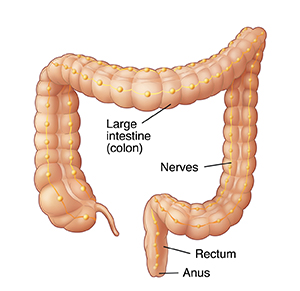When Your Child Has Hirschsprung Disease
Hirschsprung disease is a birth defect that affects the nerve cells in the large intestine (colon or bowel). These nerves allow the colon to push stool into the rectum and out the through the anus. But in a child who has Hirschsprung disease, nerve cells are missing from some or all of the colon. Without these nerves, stool can get trapped in the body and cause problems in the colon and rectum.
Hirschsprung disease occurs in about 1 in 5,000 newborns.

What are the symptoms of Hirschsprung disease?
Hirschsprung disease is most often diagnosed in newborn babies. The most common symptom is not passing stool within the first 24 to 48 hours of life. Other symptoms in newborns can include:
-
Swelling of the belly.
-
Constipation (hard, dry stool that can be hard to pass).
-
Vomiting.
-
Fever.
-
Belly pain.
-
Explosive diarrhea.
-
Not feeding well or not gaining much weight.
In some cases, the problem doesn’t cause symptoms until the child is a little older. When this happens, symptoms include:
How is Hirschsprung disease diagnosed?
Your doctor will ask about symptoms and do a physical exam. This helps find the cause of the problem. Tests may include:
-
Barium enema. A chalky liquid containing barium is inserted through the anus into the rectum. This liquid coats the inside of the colon and lower part of the small intestine so they show up on an X-ray. The X-ray shows if the colon and lower part of the small intestine are blocked by backed-up stool.
-
Rectal biopsy. A small tube is inserted through the anus into the rectum. A tiny amount of tissue is removed through the tube. In some cases, a larger amount of tissue is taken with a surgical biopsy. The tissue is studied in the lab. If no nerve cells are found in the tissue, it's a sign of Hirschsprung disease.
-
Anorectal manometry. A tube with a small balloon on its tip is inserted through the anus into the rectum. The balloon is then inflated. Normally, the balloon will stimulate nerves in the colon, causing the colon to relax and open. With Hirschsprung disease, the colon contracts and closes instead.
How is Hirschsprung disease treated?
Hirschsprung disease is treated with surgery. There are two main types of surgery:
-
Pull-through procedure. The part of the colon without nerves is removed. Then the rest of the colon is attached to the anus.
-
Ostomy. A small opening (stoma) is made in the belly so that stool can leave the body. Children who have a lot of their colon affected or who have infection or severe blockage may need an ostomy before their pull-through surgery.
These procedures may be done as:
If your child needs a stoma
Your child may need a stoma before or after surgery. This provides a new way for waste to leave the body. A small opening is made in the abdomen. This opening is connected to the colon. Waste leaves the body through this opening and empties into a bag. The stoma may be temporary or permanent, depending on how much of the colon is affected by Hirschsprung disease. If a stoma is temporary, your child will have another surgery to reconnect the bowel at a later time. If your child needs a stoma, your doctor will tell you more about it.
What are the long-term concerns?
If a large portion of the colon must be removed, your child may have long-term digestive problems. But in general, most children with Hirschsprung disease do very well after surgery. Your child may have minor problems such as constipation and stool leakage. These problems are often treated with medicine and a high-fiber diet. Children with Hirschsprung also are more likely to get an infection of the colon (enterocolitis). Your child’s doctor can tell you more about what to expect.
Online Medical Reviewer:
Chelsey Schilling BSN RN
Online Medical Reviewer:
Daphne Pierce-Smith RN MSN
Online Medical Reviewer:
Lalitha Kadali
Date Last Reviewed:
6/1/2025
© 2000-2025 The StayWell Company, LLC. All rights reserved. This information is not intended as a substitute for professional medical care. Always follow your healthcare professional's instructions.